Stunning interior lighting design in a living room involves strategic layering of light sources to create balance and adaptability. Ambient, task, and accent lighting harmonize to enhance both functionality and visual interest. Choosing proportional fixtures that complement existing decor is essential for a cohesive look. Incorporating dimmer switches allows for versatile illumination, while selecting the right bulb types influences mood and brightness. Fostering a cozy ambiance with accent lighting transforms the space, revealing creative techniques that enhance your living environment.
Key Takeaways
- Layer your lighting with ambient, task, and accent sources to create a warm and inviting atmosphere in your living room.
- Choose fixtures that are proportionate to the room size for both functionality and aesthetic appeal; consider positioning for optimal illumination.
- Utilize dimmer switches for adjustable brightness, enhancing mood and energy efficiency across different activities in the space.
- Select warm-toned bulbs (2700K-3000K) for a cozy ambiance, and incorporate dimmable options for versatility.
- Enhance spatial illusion with light-colored walls and glossy finishes while using window treatments to balance natural light and privacy.
Layering Light Sources for Balance and Adaptability

Although many homeowners overlook the intricacies of lighting design, an effective layering of light sources can transform a space from mundane to exceptional.
The foundation of this transformation rests on ambient lighting, which provides essential overall illumination, ensuring comfortable navigation while cascading a soft glow throughout the room. This foundational layer minimizes harsh shadows, contributing to a feeling of ambient warmth, and is particularly influenced by room size to ensure even light distribution. Layered combinations of fixtures can create a purposeful and inviting environment that adapts to various activities throughout the day.
To achieve a harmonious atmosphere, incorporating task and accent lighting strategically enhances functionality and visual interest. Task lighting should be positioned near work areas, while accent lighting highlights architectural features or decor, fostering depth.
Strategic Fixture Selection for Proportionality and Style

In the realm of interior lighting, selecting fixtures that harmonize in size and style is essential for achieving both functionality and aesthetic appeal.
Proportionality demands careful calculation, with fixture diameters reflecting room dimensions to maintain an inviting atmosphere, while complementary styles ensure the lighting integrates seamlessly with existing decor.
Proportional Fixture Sizing
When designing a harmonious interior, proportional fixture sizing emerges as a critical element that enhances both functionality and aesthetic appeal. Adhering to general sizing formulas ensures that pendant and ceiling fixtures align with the room dimensions, such as using the sum of length and width for diameter calculations.
This attention to fixture functionality helps establish aesthetic balance, creating a seamless visual flow within the space. When positioning fixtures over furniture, dimensions should be thoughtfully aligned; for example, a chandelier above a coffee table should be no wider than a foot less than the table’s length.
Thoughtful consideration of clearance, scale, and visual weight culminates in an ambiance that is both inviting and stylish, thereby elevating the overall interior design.
Complementary Style Choices
The art of lighting design transcends mere illumination; it intertwines with the aesthetic fabric of a space, ensuring that each fixture not only serves a functional purpose but also resonates with the overarching decor style.
Embracing current fixture trends is essential for achieving harmony between lighting and design themes. For a modern minimalist look, sleek pendant lamps with metallic finishes are ideal, while traditional elegance shines with ornate chandeliers. Industrial chic calls for raw fixtures showcasing exposed bulbs, and Scandinavian simplicity favors functional, muted designs. Bohemian styles thrive on eclectic combinations of textures and forms.
Utilizing Dimmer Switches for Versatile Illumination
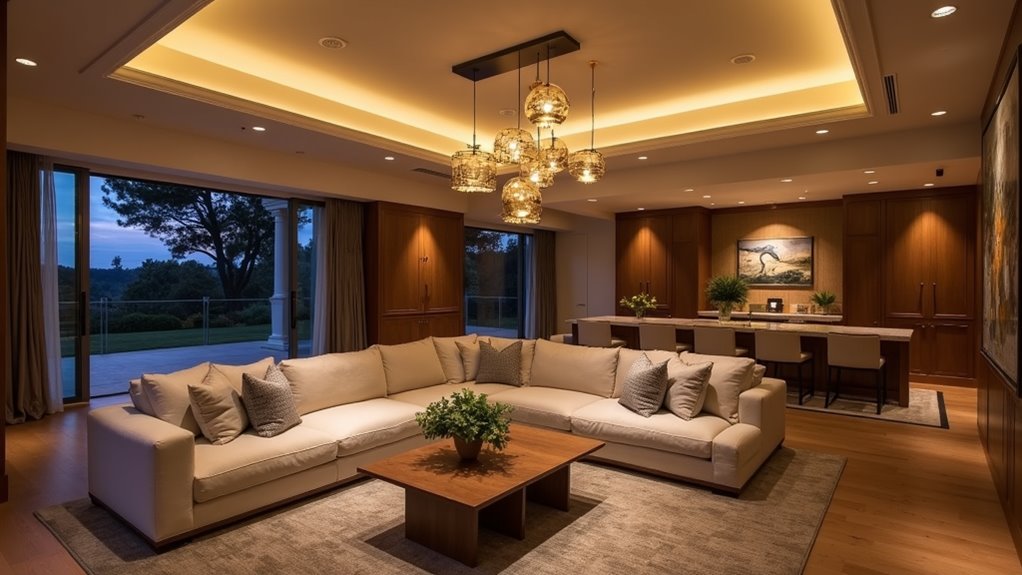
Versatile illumination can transform a space, and dimmer switches are key to achieving this dynamic effect within interior lighting design.
By incorporating dimmer switches, homeowners can enhance mood lighting and optimize energy efficiency in various settings. Here are four essential considerations:
- Dimmer Types: Explore options like rotary, slide, toggle, and smart dimmers to find the best fit for your aesthetic and usability needs.
- Dimming Technology: Consider leading-edge versus trailing-edge technology for compatibility with your chosen bulbs, particularly for energy-saving LEDs.
- Bulb Compatibility: Always confirm that bulbs are dimmable to avoid risks and ensure optimal performance.
- Installation Tips: Ensure proper wattage load and follow guidelines for safe operation to achieve desired lighting flexibility without complications.
Effective Light Placement for a Layered Look
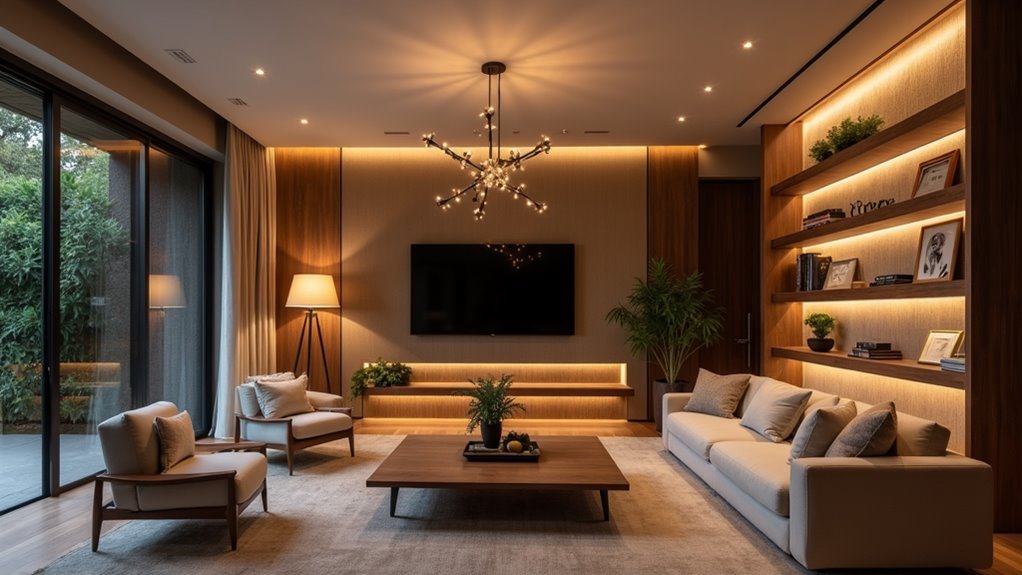
Effective light placement hinges on the strategic variation of heights and the precise direction of light.
By incorporating fixtures at different elevations—such as wall sconces, table lamps, and pendant lights—one can create a dynamic illumination that enhances spatial depth.
Additionally, directing light to key architectural features or functional areas ensures that each layer of light contributes meaningfully to the overall aesthetic.
Vary Heights Strategically
Creating a dynamic ambiance in a space can be achieved through the strategic variation of light heights, an approach that fuels visual intrigue and depth.
Height differentiation enhances vertical balance, drawing the eye across the room and creating focal points. To effectively implement this design principle, consider the following:
- Layered Fixtures: Use ceiling-mounted lights, table lamps, and floor lamps to create a multidimensional effect.
- Focus on Features: Position accent lights to highlight artwork or architectural details.
- Functional Zones: Employ varied heights to delineate areas for conversation, reading, or relaxation.
- Adjustable Elements: Incorporate flexible fixtures that can be directed to different heights, ensuring continuity and visual interest.
Through this approach, the living room transforms into a captivating, cohesive space.
Direct Light Effectively
Strategic variation in lighting heights enhances the visual allure of a space, yet the effectiveness of this approach hinges on the precise placement of direct light.
To achieve a layered look, it is crucial to integrate ambient, task, and accent lighting seamlessly. Ambient lighting serves as the foundation, while task lighting, such as adjustable floor lamps or table lamps, focuses illumination where it’s needed for activities like reading or working.
Accent lighting delivers drama by spotlighting artwork or architectural features, often significantly brighter than ambient layers. In line with contemporary lighting trends, incorporating light dimming capabilities across all layers allows for adaptable atmospheres, ensuring every moment in the living room can be perfectly illuminated.
Balancing these light sources cultivates depth and interest.
Choosing Correct Bulb Types for Brightness and Mood
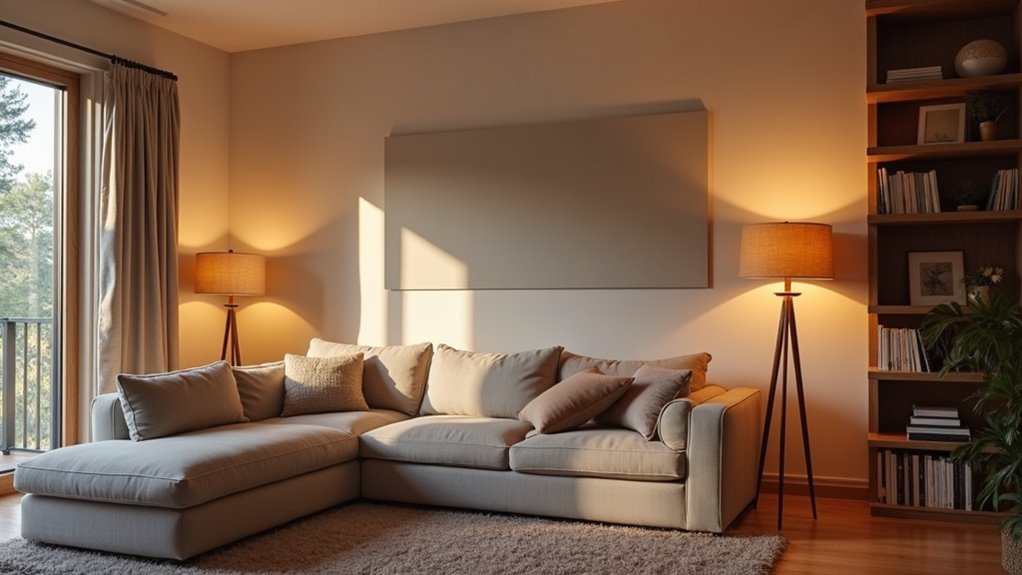
Selecting the right bulb types is essential for achieving the desired brightness and mood within a living room.
The interplay of bulb brightness and color temperature significantly influences the atmosphere. To effectively choose bulbs, consider the following:
- Lumens Matter: Aim for 1,500 to 3,000 total lumens for general brightness; choose 220-360 lumens for cozy mood lighting.
- Warmth is Key: Use bulbs between 2700K-3000K for a welcoming ambiance; lower Kelvin values provide a relaxing tone.
- Type Matters: LEDs offer energy efficiency and long life, while incandescent bulbs provide warm, inviting light.
- Dimmability: Opt for dimmable options to adapt brightness for various living room activities, enhancing overall mood lighting.
Incorporating Natural Light for a Brighter Space
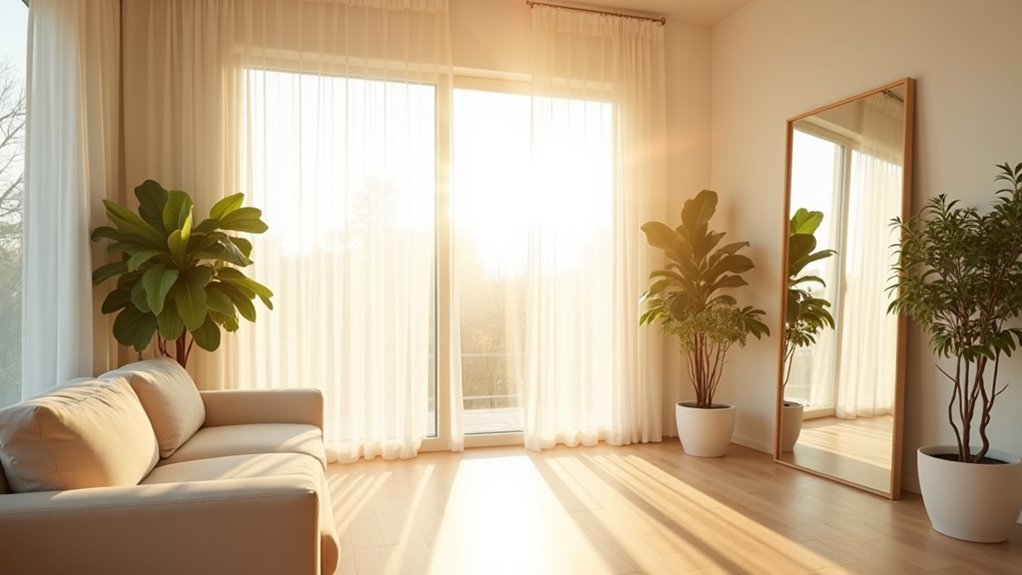
Natural light serves as an invaluable asset in interior lighting design, complementing artificial sources to elevate the overall ambiance of a living space. Implementing strategic window features, such as floor-to-ceiling windows and skylights, enhances light flow.
North-facing windows provide gentle illumination while south-facing options deliver radiant brightness. Reflective surfaces play a crucial role; strategically placed mirrors amplify sunlight, creating an illusion of spaciousness.
Light-colored walls and glossy finishes maximize light reflectance, transforming the atmosphere. Thoughtful arrangements of low-profile furniture maintain an open feel, ensuring that natural light permeates the space.
Window treatments like sheer curtains or light-filtering shades gracefully diffuse light while providing essential privacy, harmonizing functionality with aesthetic appeal for a radiant living room environment.
Creating Cozy Ambiance With Accent Lighting
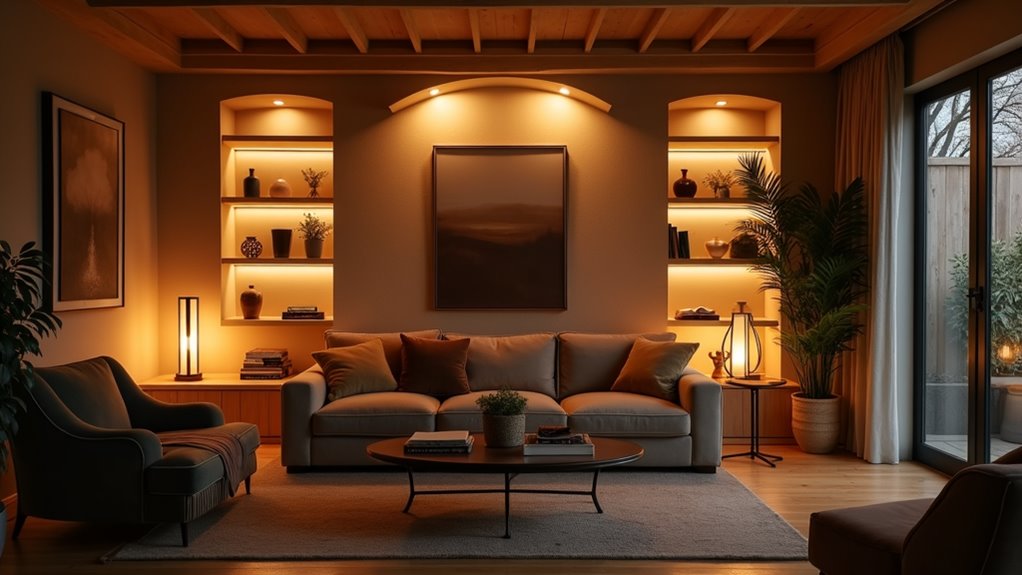
Accent lighting plays a pivotal role in cultivating a cozy ambiance within interior spaces, transforming mere rooms into inviting sanctuaries. Thoughtful accent light placement enhances mood and evokes comfort, creating inviting retreats.
To achieve this, consider:
- Highlight architectural features like textured walls or fireplaces to add depth.
- Illuminate artwork or sculptures to draw attention and create focal points.
- Use uplighting behind furniture or in corners for a gentle glow that softens shadows.
- Install LED strips within display niches to provide subtle, inviting illumination.
Layering these light sources fosters a harmonious blend, enhancing warmth and intimacy while avoiding harsh shadows or over-lighting.
This ensures every corner of the living room feels homely and inviting.


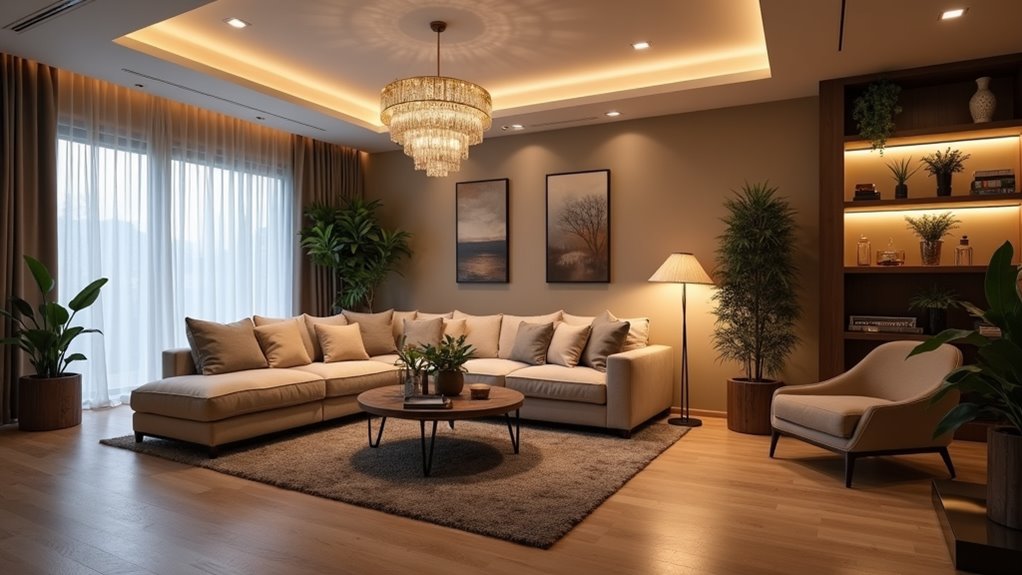
Bài viết cùng chủ đề:
3 Stunning Living Room High Ceiling Lighting Ideas
7 Creative Ideas for Living Room LED Strip Lighting
10 Essential Living Room Lighting Trends for 2025
7 Brilliant Living Room Lighting Solutions for Every Style
7 Tips for Creating Stunning Living Room Cove Lighting Designs
3 Brilliant Ideas for Living Room Floor Lighting